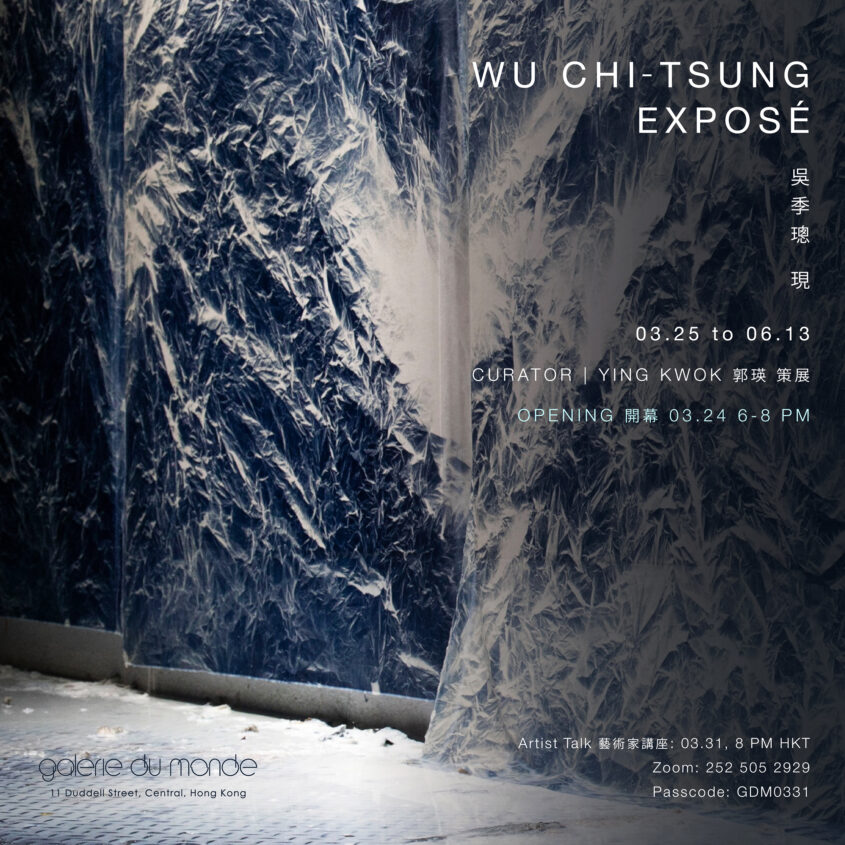
Opening Mar 24, 6 ~ 8 p.m., 2021
Public Days Mar 25 ~ Jun 13
Zoom Talk Mar 31, 8 p.m. HKT
Venue Galerie du Monde, 108 Ruttonjee Centre, 11 Duddell Street, Central, Hong Kong
HONG KONG – Galerie du Monde is pleased to present a solo exhibition by Wu Chi-Tsung: Exposé, curated by Hong Kong based Ying Kwok. Wu’s work explores light and time, and ways to recreate traditional art forms and aesthetics without losing the spirit. In Exposé, curator Kwok leads us on a journey to discover the correlation between Wu’s Cyano-Collage series and these concepts.
Born in Taipei in 1981, Wu received his BFA in 2004 from the Taipei National University of the Arts, where his training from an early age in the practices of Chinese calligraphy, ink painting, watercolor and drawing were furthered. After decades of creating experimental ink paintings, Wu turned to photography, video and installations to apply his aesthetics in classical landscapes.
Wu created his first Cyano-Collage in 2015, a further development of the earlier Wrinkled Texture series which he started in 2012. Both series explore the process of “recording light” on Xuan paper (Chinese rice paper). From Wrinkled Texture to Cyano-Collage, Wu showed he could somehow manipulate the unpredictable, creating beautiful illustrations of the relationship between man and nature.
Wu began the Wrinkled Texture series with the intention to reinterpret the traditional Texturing method (Cun Fa) of Chinese landscape painting. Instead of using ink and brush, Wu utilizes a classical photographic technique – Cyanotype, to treat his Textures. Wu first soaks the Xuan paper with a photosensitive solution, and then exposes them to sunlight for 30 minutes, while at the same time crumbling and shaping the paper into various forms and wrinkles. This exposure process is random and uncontrollable as the light intensity and the sun’s angle is different every day, at every hour.
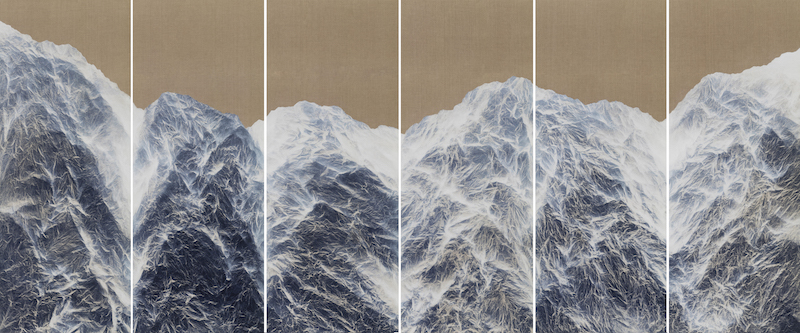
《氰山集之九十四》將於《Exposé 現》中展出
The paper is then flattened and washed in a water tank in the studio for an hour to fixate the exposed textures. This is the most intriguing part of the entire process, as it is the moment when Wu sees the outcome – the different textures and possibilities. The treated paper becomes a record of time, light, and human gestures that is marked with folds and different shades of blue.
One out of dozens of treated Xuan paper is selected by the artist. At the beginning, Wu was focused on creating a dialogue with traditional Chinese landscapes. Thus, in that period, Wu selected images that remind him of classical landscape paintings by Chinese masters. Gradually, Wu developed other references – real life landscapes, nature, or abstract paintings. It could be anything. As Wu’s practice evolves, his imagination of this series of works transforms.
Rather than limiting himself to a single sheet of Xuan paper and uncontrollable compositions, Wu discovered a new way to create his imaginary scenery on a bigger scale through experimental collages. Each Cyano-Collage is composed of many pieces of Xuan paper, individually pasted onto the canvas by Wu, and then sealing each layer with acrylic gel before adding a new one. Sometimes, Wu adds plain white Xuan paper to create depth or to erase part of an image, leaving large areas of blank space in order for the subject to leap from the painting – this is one of the most important techniques in traditional Chinese painting, termed “Liu Bai”. Wu then finishes the painting with a UV-protection varnish for long-term preservation.
Xuan paper, also known as Chinese rice paper, is a very unique medium. Compared to drawing paper or watercolor paper, Xuan paper is much thinner, more absorbent and versatile. Hence, the artist could make lots of textures through repeated crumbling. Over the past decade, Wu has studied and experimented with several dozen types of rice paper, from different origins, with varied thickness, textures, and paper making process. Wu has saved all these testing papers in his studio, and he revisits them from time to time to “read” them again and find new inspirations. A selection of these raw materials will be presented to the public for the first time in Exposé.
Exposé, the second solo exhibition of Wu Chi-Tsung at Galerie du Monde, unveils the complicated and unpredictable process behind his Cyano-Collage through an immersive viewing experience. Whether it is a painting, an installation or a video, there is always a transparent aspect in Wu’s work. It is this honesty that is so inviting, allowing for such powerful bodies of work to be fully experienced by the audience. Wu’s practice also inspires us to carry on traditions and recreate new readings of classical techniques and aesthetics. Ancient or contemporary, they shall continue to cross-pollinate and together grow into a new realm.
On Mar 31st, an online artist talk was held between the artist and curator Ying Kwok when the duo shared their first meeting at the Centre for Chinese Contemporary Art in Manchester back in 2011, and how they brainstormed, developed and presented this new project together at Galerie du Monde.
開幕 2021年3月24日晚6~8時
展覽日期 3月25日~6月13日
線上對談 3月31日晚8時
地址 香港中環都爹利街 11 號律敦治中心 108 室 世界畫廊(Galerie du Monde)
香港 - 世界畫廊(Galerie du Monde)將舉行台灣藝術家吳季璁於香港的第二場個展「現」。策展人郭瑛將引領觀眾揭開《氰山集》背後既繁複又偶然的創作過程,探索吳季璁與時間和光線之相搏鬥、磨合與交融的靜態作品。對吳季璁而言,光是他創作中的催化劑,而時間則是他的暗房。他以「時光」為手段,探索東西方傳統技法和媒材的可能性,以當代的視角延續中國水墨的美學精神,創造出連接不同文化、過去和現在的獨特藝術語言。
1981 年生於台北,吳季璁從小便兼具傳統書畫與素描水彩的藝術養成,於 2004 年畢業於國立臺北藝術大學。骨子裏受東方傳統美學影響深刻,多年來堅持實驗水墨藝術,大學時期開始探索攝影、錄像及機械光影裝置等新媒介,去微觀宏偉的山水詩意。
《氰山集》於 2015 年面世,此系列作品源於吳季璁於 2012 年開創的《皴法習作》,發想自水墨畫中的「皴法」概念。皴法是傳統中國文人繪畫中的核心技法,以書法的筆墨精神,對山石紋理概括描繪,畫家藉此投射個人內心的山水景物,寄情其中。吳季璁以宣紙為媒介,運用古老的氰版攝影沖印技術藍曬法替代筆墨。
吳季璁先將感光材料塗在紙張上,在陽光下曝曬約三十分鐘,過程中不斷重塑紙張皺摺,壓平後再經一小時的水洗程式,將皴法定影。水洗步驟非常重要,不單是要停止陽光與宣紙的化學反應,也是整個程序中最有趣的一環,皴法的色調和紋路首次顯示於藝術家眼前。此刻,時間、陽光的線條、和人類觸感都被記錄在海藍的宣紙上。陽光和天氣隨著時間一直在變化,所以吳季璁每一次曬紙都是一次偶然,最終呈現在紙上的皴法紋路變幻莫測。
曝曬後的宣紙被壓平和風乾後,吳季璁會仔細「閱讀」每張宣紙上的皴法紋路,從而進行篩選。一般在數十張宣紙中,吳季璁能選出一張裁剪為《皴法習作》作品。創作初期,吳季璁強調重現中國山水,與古代書畫大師產生對話,所以該時期選出的紙張都帶有山水詩意的皴法紋路。隨著時間的推移,吳季璁想要表達的語境也在變化。真實的風景、大自然、抽象藝術等,世間上所有事物都能成為吳季璁的靈感,從《皴法習作》到《氰山集》的突破見證他思想及想像力的蛻變歷程。
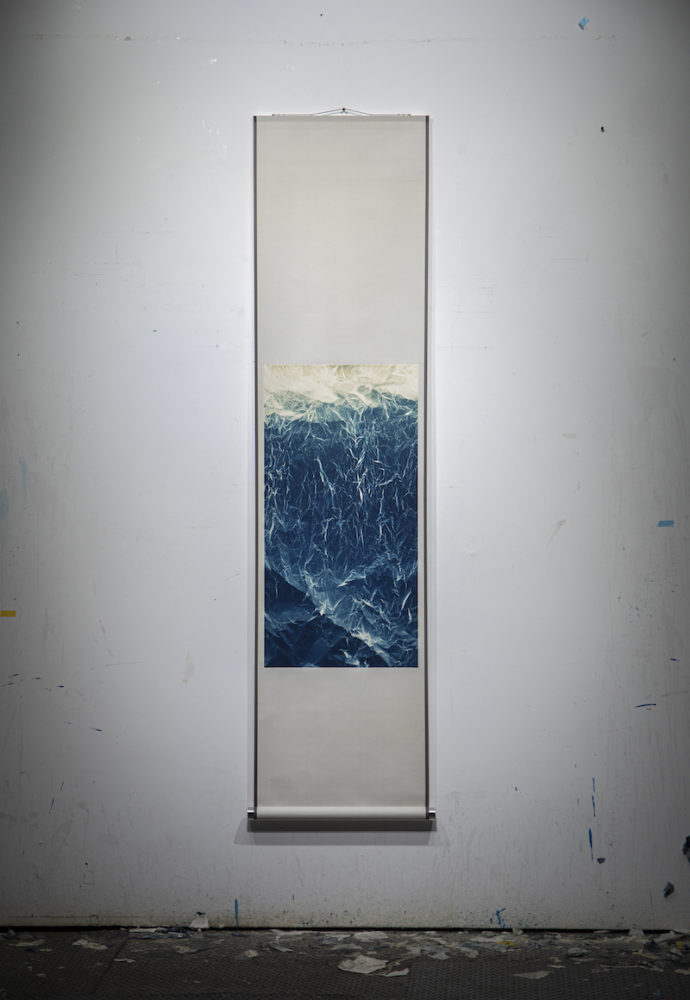
《皴法習作之九十七》將於《Exposé 現》中展出
經過三年對宣紙和藍曬法的研究,吳季璁於 2015 年創作出第一件《氰山集》作品,擺脫了畫面大小的局限和佈局的偶然性,將曝曬過後的紙張在畫布上拼貼成叢山萬嶺景象,進一步探究傳統繪畫的美學。宣紙質感柔薄,可讓吳季璁隨心貼附在畫布或木板上,用刷子刷平,再塗上五、六層壓克力膠進行固定。每次加上新的一層紙,吳季璁都會加進白紙,以中國傳統繪畫中的「留白」技法來調整構圖。最後,吳季璁會在畫面塗上防紫外線的保護漆。
宣紙的材料屬性是吳季璁創作初期的一大挑戰,其變化性和複雜度遠大於一般氰版攝影中使用的相紙。多次實驗後,吳季璁逐漸發現宣紙是格外特殊而精彩的材料。西方常見的紙張,像水彩紙,表面有塗層,無論多厚重的顏料都只會停留在表層。東方沒有放礬的生紙,雖然很薄,卻能夠將顏料吸收在紙纖維裏,把時間的變化記錄在紙上,創造出更多的可能性。
郭瑛於「現」中帶領觀眾探索吳季璁在過去九年的成長,揭開《氰山集》的創作歷程。不論是畫作、裝置或影像,吳季璁的作品中都在演繹時間的流動性,從曝光到拼貼,它不是單純靜態的東西,而是記錄著動態與韻律。吳季璁借助攝影來思考與表達,對攝影、繪畫、山水、空間作出提問,無止境地尋找新的可能,在跨文化的語境中開發東西方藝術傳統新的火花。
3月31日,吳季璁與策展人郭瑛還進行了一場線上對談。兩人分享了2011年在曼徹斯特中國當代藝術中心的第一次相遇,以及本次他們如何在世界畫廊的支持下集思廣益,構思、設計以至於呈現出本次展覽的種種細節與趣事。
Installation Views 展覽現場
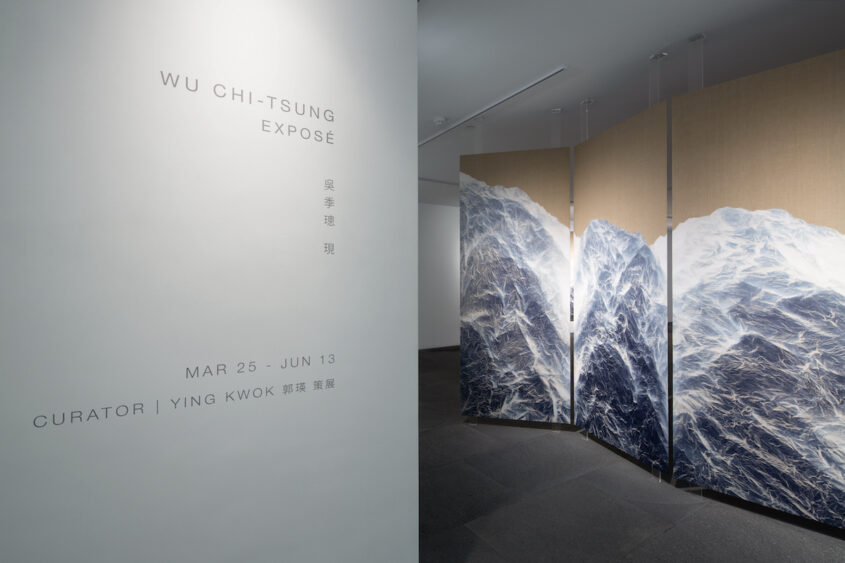
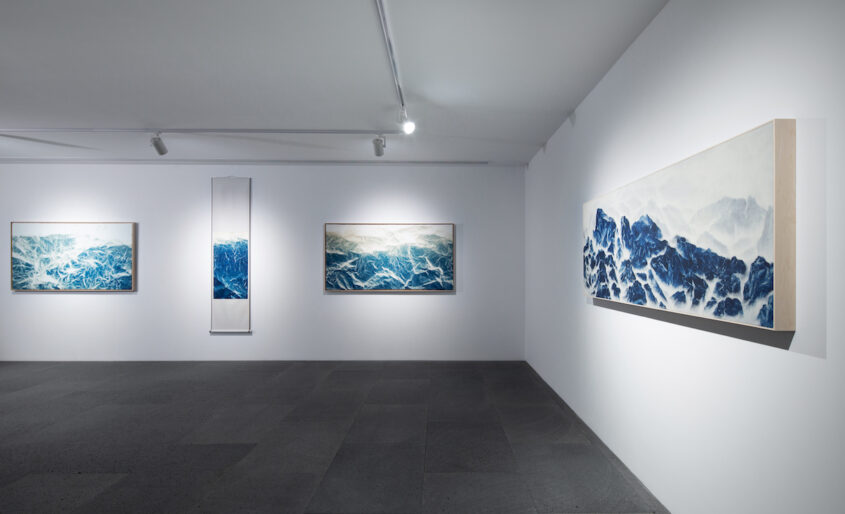
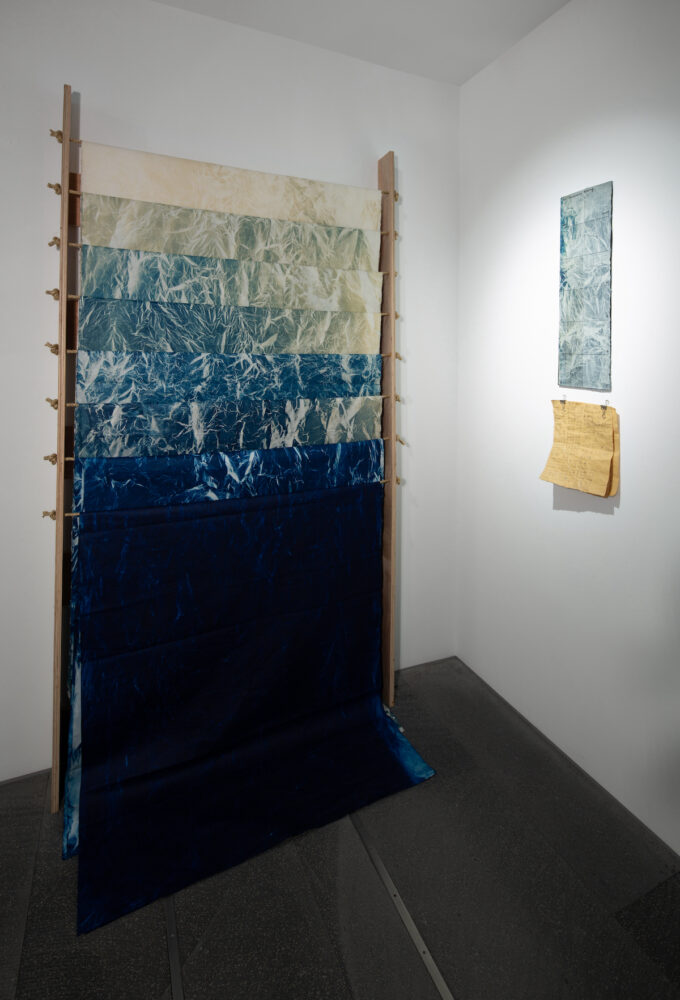
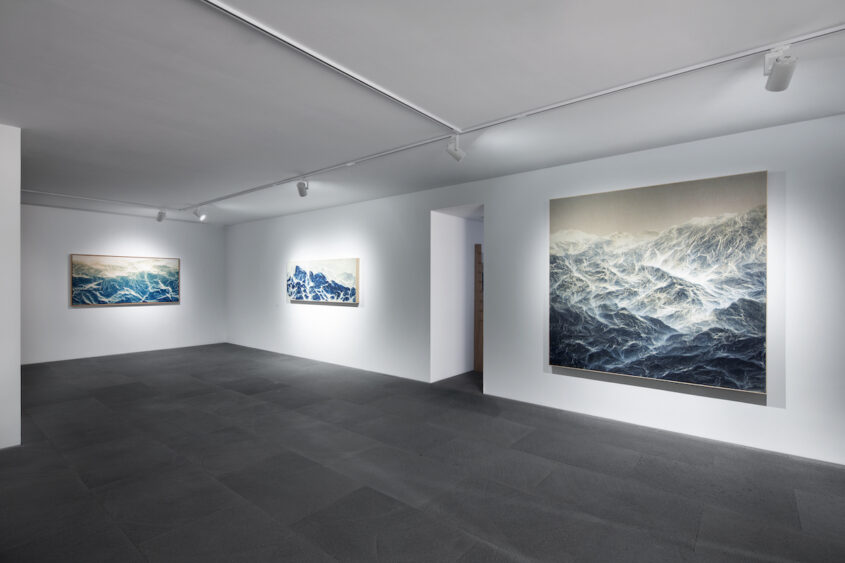
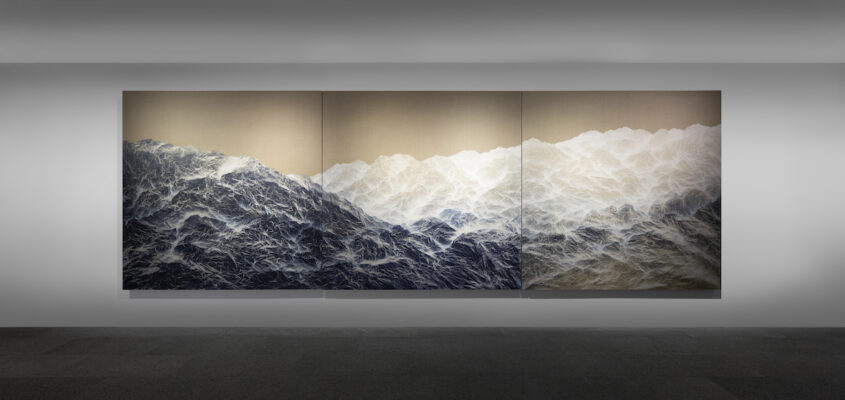
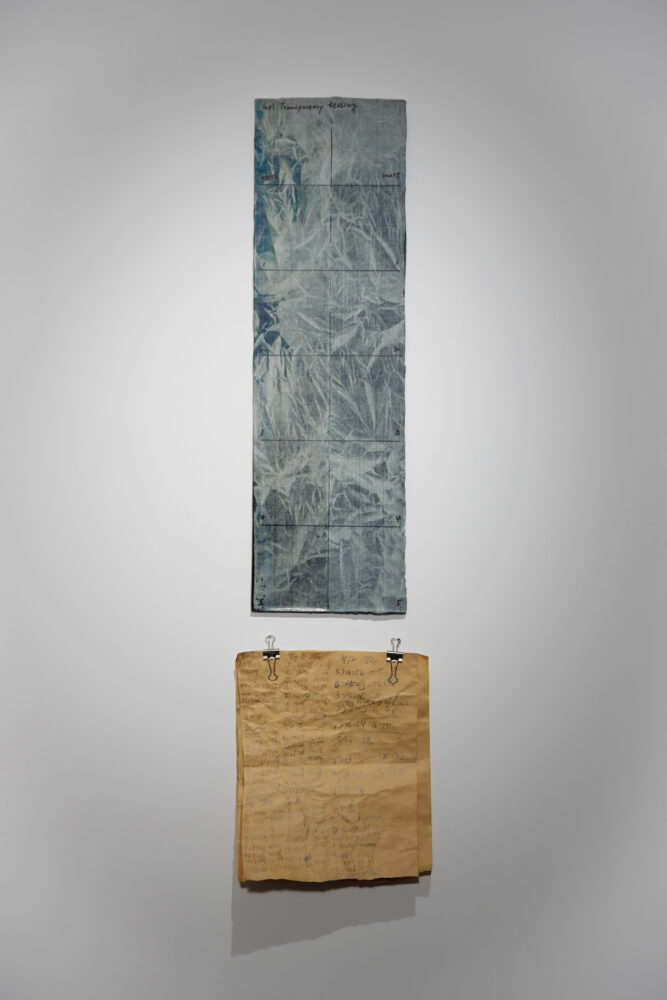
Media Coverages 媒體報導
10 Must-See Art Exhibitions In Hong Kong In April 2021, Tatler Hong Kong, April 2, 2021
A Comprehensive Round-up of the Best Art Exhibitions to Visit this Month, Lifestyle Asia, April 8, 2021
Art of Chance and Coincidence, *CUP, April 1, 2021
Time, Light, and Experiment, OBSCURA Magazine, April, 2021
On the Limitless Imagination in Wu Chi-Tsung’s Interdisciplinary Arts, Heyshow.com, May, 2021
Beneath the Surface: Wu Chi-Tsung, ArtAsiaParcific, June, 2021